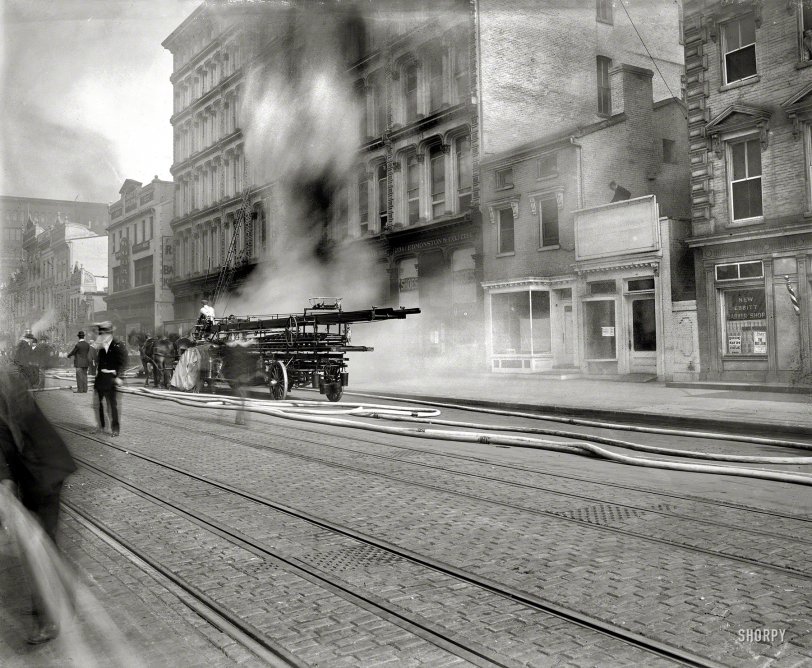


Framed or unframed, desk size to sofa size, printed by us in Arizona and Alabama since 2007. Explore now.
Shorpy is funded by you. Patreon contributors get an ad-free experience.
Learn more.

- Lofty addition
- In 1912
- Keenan Building
- Six years old
- Taken from the P.J. McArdle Roadway?
- It stood only 47 years
- Three track mind
- Incline to the right
- Reach for the sky, 1912 style
- No clean sweep
- Same Job Title, Same Face
- Sadly Lost
- Beautiful ...
- Where you get your kicks
- Aim High
- Pueblo Revival sisters
- Pueblo Neoclassicism
- Milk Man
- Regional dialect.
- Spielberg's inspiration
- Great Photo
- Loaf Story
- Do you still have the Rakes category?
- Could almost be a scene from the 1957 movie 'Hell Drivers'
- The Wages of Fear.
- Conspicuous by their absence
- Got Milk?
- All that aluminum
- No lefties
- Smoke 'em if you've got 'em
Print Emporium
Fire on F Street: 1913

May 18, 1913. Washington, D.C. "U.S. Geological Survey fire, F Street N.W." The blaze was largely confined to the basement. National Photo Co. View full size.
Stubborn Blaze
Other photos of horse-drawn DCFD apparatus at:
- Where's the Fire: 1914. (galloping horses!)
- The Smoking Bed: 1915.
- Spontaneous Combustion: 1916.
Washington Post, May 19, 1913.25 Firemen Overcome Fighting Hard Blaze In Geological Survey
Fifteen firemen, including Chief Wagner, were taken to the Emergency Hospital, some suffering from convulsions; many of their comrades were felled by noxious fumes and carried into the open, where they were revived by fellow firefighters; the office of the American Express Company was completely wrecked, and the stock in adjacent stores damaged to an extent of thousands of dollars, in the most stubborn fire with which the Washington fire department has had to deal in the past twenty years, which was discovered in the basement of the building occupied by the geological survey, in F street, between Thirteenth and Fourteenth streets northwest, at 3:30 o'clock yesterday afternoon. …
“It was the nastiest fire to fight that I have ever seen,” said the chief. “If it had ever got up the stairway to the elevator shaft it is likely that we couldn't have saved the building. We had to keep it in the cellar, smoke or no smoke. We had to get in close to it, too, and the smoke made it very difficult to do that. That is why it was such a hard fire to cope with.” …
The fire started in the cellar with the spontaneous combustion of a stack of documents or a quantity of chemicals in a small laboratory adjoining the storeroom. It had made considerable headway when John Watson, the watchman, discovered it and turned in an alarm. …
The first firemen rescued from their dangerous post, and who were able to talk, told of breathing illuminating gas as soon as they had gone down the ladders. A quick investigation showed that the illuminating gas had not been shut off from the building by the employee of the gas company assigned to that duty. The fire worked its way back and burned the gas meter from the feed pipe. The flow of gas from the open pipe combined with the gases generated from the smouldering coal bunkers made conditions deadly to any fireman who entered the basement, and also accounts for the stubbornness with which the fire from the time of its discovery at 3:45 o'clock until 7 o'clock, resisted their efforts to conquer it. …
























On Shorpy:
Today’s Top 5